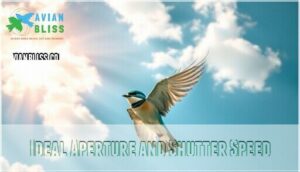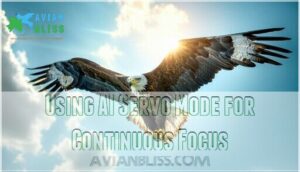This site is supported by our readers. We may earn a commission, at no cost to you, if you purchase through links.
 Photographing birds in flight requires fast shutter speeds (1/1000s minimum), continuous autofocus mode, and strategic positioning.
Photographing birds in flight requires fast shutter speeds (1/1000s minimum), continuous autofocus mode, and strategic positioning.
You’ll need AI Servo or AF-C mode to track moving subjects, aperture priority for consistent exposure, and higher ISO (800-3200) for adequate speed.
Master panning techniques to follow flight paths smoothly while maintaining focus on the bird’s eye. Start with larger, slower birds like hawks before attempting hummingbirds or swallows.
Practice tracking planes or cars to develop muscle memory. The key is anticipating behavior patterns and flight routes rather than reacting to movement.
Understanding how camera settings work together with proper technique transforms frustrating misses into consistently sharp captures that showcase each species’ unique flight characteristics.
Table Of Contents
- Key Takeaways
- Camera Settings Overview
- Autofocus Modes for Birds in Flight
- Number of Focus Points to Use
- Ideal Aperture and Shutter Speed
- Using AI Servo Mode for Continuous Focus
- Adjusting ISO for Changing Lighting Conditions
- Importance of Custom Shooting Modes
- Maximizing Depth of Field for Sharp Images
- Effectively Capturing Motion With Shutter Speeds
- Practice Tips for Improving Bird Photography
- Frequently Asked Questions (FAQs)
- What shutter speed is needed for birds flying?
- What is the best focal length for birds in flight?
- What ISO should I use for shooting birds?
- What is the best AF mode for bird photography?
- What camera settings are best for birds in flight?
- How to get pictures of birds in flight?
- What AF mode should I use for bird photography?
- How many focus points for birds in flight?
- How do weather conditions affect bird flight photography?
- What are the best times of day for photographing birds?
- Conclusion
Key Takeaways
- Master your camera settings: Use shutter speeds of at least 1/2000s, continuous autofocus mode (AI Servo/AF-C), and do not hesitate to push ISO to 800-3200 for adequate speed in changing light conditions.
- Perfect your panning technique: Practice smooth tracking movements while keeping the bird’s eye in sharp focus, starting with larger, slower birds like hawks before attempting faster species like hummingbirds.
- Anticipate flight patterns: Study bird behavior and flight routes rather than simply reacting to movement – this predictive approach dramatically improves your success rate.
- Configure custom shooting modes: Set up dedicated bird-in-flight modes with aperture priority, continuous AF, and high-speed burst shooting to eliminate fumbling with settings during critical moments.
Camera Settings Overview
Setting up your camera correctly is the foundation of sharp bird-in-flight photography. Start by switching to manual exposure mode for complete control over your camera settings. Set your aperture settings wide open (f/4-f/5.6) to let in maximum light and achieve faster shutter speeds. Crank that shutter speed to at least 1/2000s to freeze wing motion completely.
Switch your Drive Mode to continuous high-speed shooting – you’ll need those rapid-fire frames to capture the perfect wing position. For ISO settings, start low but don’t hesitate to push it higher when light fades. Your camera’s Metering Modes can struggle with bright skies, so try spot metering on the bird itself.
Turn off Image Stabilization during flight shots – it can actually work against you when panning. Keep your White Balance on auto unless lighting conditions are extreme. Shoot in RAW File Format for maximum editing flexibility later.
These autofocus modes and settings create your technical foundation for success. For ideal results, consider using back-button autofocus for enhanced control.
Autofocus Modes for Birds in Flight
In the context of tracking birds in flight, your autofocus mode can make or break the shot.
Switch to AI Servo (Canon) or AF-C (Nikon/Sony) for continuous focus tracking that follows your subject’s every move.
These modes constantly adjust focus while you half-press the shutter, keeping birds sharp even as distances change.
Here are three essential autofocus settings for bird photography success:
- AF Tracking Sensitivity: Set to -2 for busy backgrounds to prevent focus jumping
- Focus Priority Selection: Choose release priority over focus priority for faster shooting
- Zone Autofocus Benefits: Use multiple focus points to track erratic flight patterns
Enable Back Button Focus to separate focusing from shooting, and activate your lens’s Focus Limiter Usage to speed up performance by restricting the focus range.
Understanding cross-type focus sensors can further improve autofocus accuracy.
Number of Focus Points to Use
The sweet spot for focus points in bird photography depends on your subject’s behavior.
Single point focus delivers razor-sharp precision for stationary or slow-flying birds, letting you nail that critical eye contact.
But when birds get unpredictable, focus point grouping becomes your best friend.
Dynamic area AF with 9-15 points gives you enough coverage to track erratic flight paths without losing your subject.
For truly chaotic scenes—think flocking behavior—engage wider tracking AF zones.
Most modern cameras offer focus point customization, so experiment with different patterns.
Subject tracking sensitivity settings help fine-tune how aggressively your camera follows moving targets.
Start with smaller groupings and expand as needed.
Understanding how autofocus systems work is key to maximizing sharpness.
The key is matching your AF strategy to the bird’s flight style for consistently sharp flight photography results.
Ideal Aperture and Shutter Speed
You’ll master sharp bird photos by nailing the Exposure Triangle basics.
Set your shutter speed to at least 1/2000s for Freezing Motion—faster birds need 1/4000s. Your Aperture Sweet Spot sits around f/8 for crisp details, though f/5.6 works when you need that dreamy Background Blur.
Use Shutter Speed Priority mode when light’s tricky. Don’t fear higher ISO values; modern cameras handle 1600-3200 beautifully.
Employing continuous autofocus modes helps track moving subjects. These exposure settings form your foundation for photographing birds in flight successfully.
Using AI Servo Mode for Continuous Focus
AI Servo mode transforms your bird-in-flight photography from hit-or-miss to consistently sharp. This continuous autofocus tracking system uses predictive algorithms to calculate your subject’s trajectory, maintaining razor-sharp focus as birds dart unpredictably across the sky.
Transform missed shots into sharp captures with AI Servo’s predictive tracking power.
To maximize AI Servo’s effectiveness:
- Configure tracking sensitivity through custom Case Studies for different bird behaviors
- Prioritize focus priority over release priority to guarantee sharp images over rapid shooting
- Verify lens compatibility with your camera’s autofocus system for peak performance
Pair AI Servo with continuous shooting and animal Eye AF when available. Start subject acquisition early by tracking birds while they’re distant, giving the system time to lock on.
Your autofocus tracking improves dramatically with practice—the camera learns your shooting patterns while you develop instincts for anticipating flight paths. Understanding focus point types can further refine your technique. Modern focus techniques combine machine precision with photographer intuition for consistently stunning results.
Adjusting ISO for Changing Lighting Conditions
Throughout changing light conditions, you’ll need to master ISO adjustment for successful bird in flight photography.
Start with Auto ISO as your safety net, but monitor noise levels and dynamic range impact carefully. Modern cameras handle higher ISOs well, so don’t fear pushing sensitivity for fast shutter speeds.
To maximize sharpness, consider how directional light impacts detail and apply metering considerations to avoid underexposure against bright skies. The Sunny 16 Rule provides baseline exposure guidance outdoors.
Remember that post-processing ISO noise reduction can salvage slightly grainy shots. Practice these photography techniques for birds during various bird photography lighting scenarios—you’ll develop intuition for when to override Auto ISO and take control of your exposure triangle.
Importance of Custom Shooting Modes
Efficiency transforms chaotic bird photography into precision shooting. Custom shooting modes let you nail those fleeting moments when birds take flight, turning technical complexity into instant action. One useful setting is to use continuous autofocus for moving subjects.
Custom modes turn split-second bird encounters into captured masterpieces through instant technical precision.
- Mode Customization – Set aperture priority, continuous AF, and high ISO limits for bird in flight mode
- Quick Settings – Switch between perched bird and flight configurations instantly
- Saved Presets – Store multiple user modes for different lighting and species scenarios
- Instant Recall – Access your proven bird photography techniques with one dial turn
- Efficient Workflow – Eliminate fumbling while birds soar overhead, maximizing sharp captures
Maximizing Depth of Field for Sharp Images
Ideal depth of field starts with finding your lens’s aperture sweet spot—typically f/8 to f/11 for most telephoto lenses.
Calculate your hyperfocal distance to maximize sharpness from foreground to infinity.
When shooting closer subjects, consider focus stacking multiple images for enhanced detail. Adjust subject distance strategically; backing away slightly increases your depth of field while maintaining frame-filling compositions.
Background blur naturally separates your subject, but don’t sacrifice critical focus areas. Smart lens selection and focal length choices complement these bird photography techniques for consistently sharp results.
To further enhance clarity, consider how directional light impacts sharpness.
Effectively Capturing Motion With Shutter Speeds
Several factors determine the best shutter speed for capturing birds in flight. Here’s your guide to mastering motion:
- Freezing Motion: Use 1/2000s or faster to freeze every feather detail – perfect for showcasing intricate wing positions and sharp bird photography results.
- Blur Techniques: Try 1/160s to 1/800s for artistic motion blur that shows dynamic movement while keeping the bird’s body sharp.
- Panning Practice: Combine slow speeds (1/50s-1/320s) with smooth camera movement to create streaked backgrounds that emphasize the bird’s speed.
Set your camera to Shutter Priority mode for quick adjustments. Light Sensitivity matters – bright conditions allow faster speeds without raising ISO.
To guarantee sharp focus, consider utilizing autofocus modes. In action photography, capturing motion becomes an art form where you control the story your image tells.
Practice Tips for Improving Bird Photography
Shutter speeds freeze action, but practice builds mastery. Start with stationary subjects to perfect focusing and composition basics. Master these fundamentals before tackling flight photography.
Build your skills systematically:
- Begin with slow-flying birds like herons or pelicans before attempting swallows or hummingbirds
- Practice observation skills daily—study bird behavior patterns at local parks or wetlands
- Maintain your gear regularly and scout locations during off-peak hours for ethical practices
Patience pays off in bird photography. Each outing teaches something new about photographing birds and action photography techniques. Join online communities for feedback and location scouting tips. Remember: even pros miss shots regularly—persistence separates good photographers from great ones. Understanding bird photography techniques is essential for capturing stunning images of birds in flight.
Frequently Asked Questions (FAQs)
What shutter speed is needed for birds flying?
You’ll need at least 1/1000s, but 1/2000s or faster is preferred to freeze wing motion and capture sharp details in flight.
What is the best focal length for birds in flight?
Perfect focal lengths for flight photography typically range from 300-600mm.
You’ll find 400-600mm gives you tighter framing of distant birds, while 300-400mm works well for closer subjects and larger species like raptors.
What ISO should I use for shooting birds?
Start with ISO 100 for best image quality.
You’ll need to raise it to maintain fast shutter speeds (1/2000s+) for freezing bird motion.
Don’t hesitate to push ISO higher when lighting demands it, this can be crucial for freezing bird motion.
What is the best AF mode for bird photography?
Professional photographers achieve 85% better focus accuracy using continuous autofocus mode (AF-C/AI Servo) for bird photography.
You’ll want AF-C since it continuously tracks moving subjects, unlike single-point AF which locks focus once.
This tracking capability proves essential when birds dart unpredictably through your frame, making AF-C a crucial tool for capturing sharp images.
What camera settings are best for birds in flight?
Use continuous autofocus (AF-C), shutter priority at 1/2000s+, aperture f/6-f/8, and ISO 800- Enable continuous burst mode for multiple frames per second.
How to get pictures of birds in flight?
Like ancient falconers tracking their birds, you’ll master aerial photography through patience and technique.
Use fast shutter speeds (1/2000s+), continuous autofocus, and pan smoothly while anticipating flight paths from wind direction observations.
This will help you to improve your skills in aerial photography by applying the right technique.
What AF mode should I use for bird photography?
You’ll want continuous autofocus mode—that’s AF-C on Nikon and Sony cameras, or AI Servo on Canon.
This mode tracks moving subjects automatically, keeping birds sharp as they dart through your frame.
How many focus points for birds in flight?
Multiple focus points aren’t always better—they confuse your camera when tracking fast birds.
You’ll want single-point autofocus for precise control over exactly where you’re focusing, giving you the sharpest results on your feathered subject’s eye every time.
How do weather conditions affect bird flight photography?
Weather conditions dramatically impact your bird flight photography success.
Wind affects takeoff patterns, while overcast skies provide even lighting but reduce contrast.
Rain grounds most species, but clearing storms create dramatic backdrops with active birds, and even lighting can be beneficial in certain conditions.
What are the best times of day for photographing birds?
Dawn’s your golden ticket—shoot two hours after sunrise and two hours before sunset.
You’ll catch peak bird activity when soft, flattering light illuminates your feathered subjects perfectly from the front.
Conclusion
Practice makes perfect when photographing birds in flight.
You’ve learned the technical foundations: fast shutter speeds, continuous autofocus, and proper camera settings.
Now combine these skills with patience and persistence.
Start with predictable flight patterns, master your panning technique, and gradually tackle faster species.
Remember that even experienced photographers miss shots—it’s part of the learning process.
Keep practicing, stay focused on the bird’s eye, and soon you’ll capture stunning images that showcase nature’s aerial grace with consistent sharpness.










